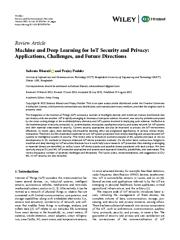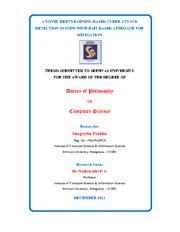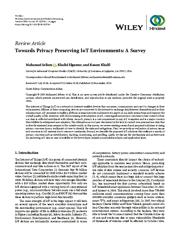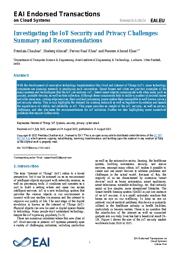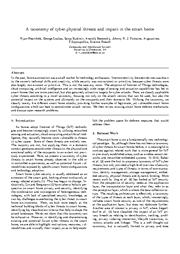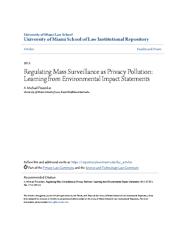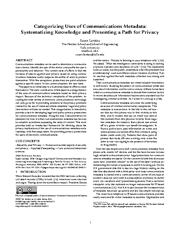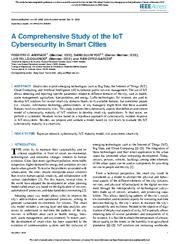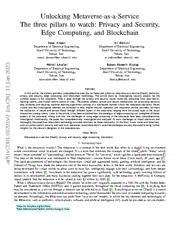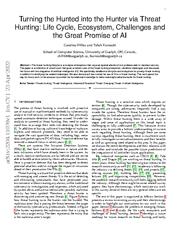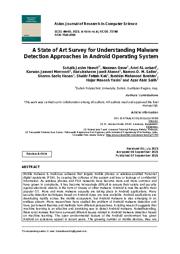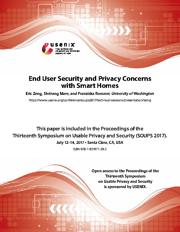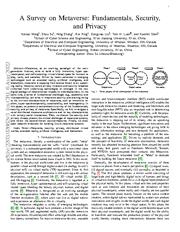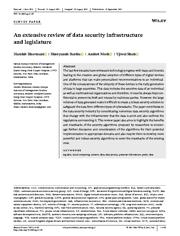A copy of this work was available on the public web and has been preserved in the Wayback Machine. The capture dates from 2022; you can also visit the original URL.
The file type is application/pdf.
Filters
Machine and Deep Learning for IoT Security and Privacy: Applications, Challenges, and Future Directions
2022
Security and Communication Networks
In recent years, deep learning (DL)/machine learning (ML) has progressed significantly in various critical implementations. ...
On the other hand, various new insights in machine and deep learning for IoT securities illustrate how it could help future research. ...
Internet traffic to and from a smart home has been used by opponents before to determine a person's activities or even their presence at the residence.
Smart Cities. ...
doi:10.1155/2022/8951961
fatcat:n4rb7rtgrjbybmen66oyrzkhle
A NOVEL DEEP LEARNING BASED CYBER ATTACK DETECTION SYSTEM WITH BAIT BASED APPROACH FOR MITIGATION
2024
Zenodo
For stealing data from infected targets, most cybercriminals take advantage of internet-centric services. ...
By aiming at commercial enterprises, elevated valued persons, and government that is linked to the Internet, much malware is propagated via the internet. ...
Wireless intrusion prevention system (WIPS): Looks for any suspicious traffic by analyzing network protocol activity throughout the whole wireless network. iii. ...
doi:10.5281/zenodo.10867501
fatcat:yutmiq3jkvdfhkkbo5vloxx4u4
Towards Privacy Preserving IoT Environments: A Survey
2018
Wireless Communications and Mobile Computing
IoT promises to enable a plethora of smart services in almost every aspect of our daily interactions and improve the overall quality of life. ...
The ultimate source of user discomfort is the lack of control over personal raw data that is directly streamed from sensors to the outside world. ...
Wireless Communications and Mobile Computing
Conflicts of Interest The authors declare that there are no conflicts of interest regarding the publication of this paper. ...
doi:10.1155/2018/1032761
fatcat:j76yhuc5rjhvbifkk5foq3klzq
Applications and Techniques for Fast Machine Learning in Science
2022
Frontiers in Big Data
In this community review report, we discuss applications and techniques for fast machine learning (ML) in science—the concept of integrating powerful ML methods into the real-time experimental data processing ...
For wireless communication, signal interference and network traffic conditions are captured via multispectral data. ...
Noise reduction in gravitational-wave data via deep learning. Phys. Rev. ...
doi:10.3389/fdata.2022.787421
pmid:35496379
pmcid:PMC9041419
fatcat:5w2exf7vvrfvnhln7nj5uppjga
Investigating the IoT Security and Privacy Challenges: Summary and Recommendations
2022
EAI Endorsed Transactions on Cloud Systems
Smart homes and cities are just two examples of the many systems and technologies that the IoT can endorse. ...
IoT - based smart objects communicate with other parts, such as proxies, portable devices, as well as data collectors. ...
The authors gratefully acknowledge the support from Department of Computer Science & Engineering, Azad Institute of Engineering & Technology, Lucknow, Uttar Pradesh, India. ...
doi:10.4108/eetcs.v7i22.2652
fatcat:h7caszefovh33a62s5pq7r5zpi
A taxonomy of cyber-physical threats and impact in the smart home
2018
Computers & security
Utilising the taxonomy, we classify twenty five different smart home attacks, providing further examples of legitimate, yet vulnerable smart home configurations which can lead to second-order attack vectors ...
We then review existing smart home defence mechanisms and discuss open research problems. ...
At the same time, the presence or not of people in a smart home can be inferred through the level of wireless network activity (e.g., of ZigBee traffic). ...
doi:10.1016/j.cose.2018.07.011
fatcat:cq6g7sb5uvaavoth4myqadhmau
Regulating Mass Surveillance as Privacy Pollution: Learning from Environmental Impact Statements
2014
Social Science Research Network
Koonin for sharing his slides from his stimulatingand, frankly, terrifyingtalk about CUSP at the Simons Foundation in March, 2013 which inspired this article, and also for providing additional information ...
analogy, the PINs proposal seeks to present a domesticated form of regulation with the potential to ignite a regulatory dynamic by collecting information about the privacy costs of previously unregulated activities ...
Smart dust is still on the drawing board, with applications ranging from monitoring our movements to monitoring our insides. See Quentin Hardy, Big Data in Your Blood, N.Y. ...
doi:10.2139/ssrn.2400736
fatcat:5hpcg2ush5a45emfwkgtodnini
Categorizing Uses of Communications Metadata: Systematizing Knowledge and Presenting a Path for Privacy
2020
New Security Paradigms Workshop 2020
This work has greatly benefited from comments provided by David Balenson, Jono Spring, Tom Walcott, and other participants in the New Security Paradigms Workshop. I am very grateful for their help. ...
Such spying is particularly important due to increased use of encryption. ...
The smart home has made this real; in 2019 Apthorpe et al. ran tests showing how "a passive network observer could . . . infer consumer behavior from rates of IoT device traffic, even when the traffic ...
doi:10.1145/3442167.3442171
fatcat:ididy32gujdrbictvjytvtshnu
A Comprehensive Study of the IoT Cybersecurity in Smart Cities
2020
IEEE Access
INDEX TERMS Bayesian network, cybersecurity, IoT, maturity model, risk assessment, smart city. ...
Besides, we propose and validate a model based on risk levels to evaluate the IoT cybersecurity maturity in a smart city. ...
Some cyberattacks that can occur in a smart city are: • Controlling traffic lights: attackers can manage city lights causing accidents; traffic signals have become susceptible to attacks because of wireless ...
doi:10.1109/access.2020.3046442
fatcat:o7pbraolzbcgxjj5camkkz73pe
Unlocking Metaverse-as-a-Service The three pillars to watch: Privacy and Security, Edge Computing, and Blockchain
[article]
2023
arXiv
pre-print
Then it goes through the privacy and security issues inside the metaverse from data-centric, learning-centric, and human-centric points-of-view. ...
The article starts by investigating security aspects for the wireless access to the metaverse. ...
Networking connectivity is then provided via wireless networks, while the computing and storage are provisioned through cloud and edge computing. ...
arXiv:2301.01221v2
fatcat:njzop26brrculbncsuxhhry6c4
Turning the Hunted into the Hunter via Threat Hunting: Life Cycle, Ecosystem, Challenges and the Great Promise of AI
[article]
2022
arXiv
pre-print
The threat hunting lifecycle is a complex atmosphere that requires special attention from professionals to maintain security. ...
Deep cross-lingual models have been used to jointly learn the common representation from two languages [209] . ...
Deep learning models have been implemented to attribute Threat actors based on threat reports obtained from various Threat Intelligence sources [196] . ...
arXiv:2204.11076v1
fatcat:jc3bghaiungxxlta5itgjnla2a
A State of Art Survey for Understanding Malware Detection Approaches in Android Operating System
2021
Asian Journal of Research in Computer Science
So, there is a need for smart malware detection systems to reduce malicious activities risk. ...
Many researchers have studied the problem of Android malware detection and have put forward theories and methods from different perspectives. ...
This reduced the reliability of those solutions [92] DL-Droid, deep learning To detect malicious apps from Android. ...
doi:10.9734/ajrcos/2021/v11i330266
fatcat:fcaiwoexh5hk7dce6triq3eu5y
End User Security and Privacy Concerns with Smart Homes
2017
Symposium On Usable Privacy and Security
To bridge this gap, we conduct semi-structured interviews with fifteen people living in smart homes (twelve smart home administrators and three other residents) to learn about how they use their smart ...
From these and other findings, we distill recommendations for smart home technology designers and future research. However, despite an increased focus on smart home security, ...
We also thank Luis Ceze for useful conversations about smart home setups, as well as Yoshi Kohno, Kiron Lebeck, Lucy Simko, and Anna Kornfeld Simpson for reviewing an earlier draft. ...
dblp:conf/soups/ZengMR17
fatcat:nfinss3wfjattfxhtzlo2hs27q
A Survey on Metaverse: Fundamentals, Security, and Privacy
[article]
2022
arXiv
pre-print
However, severe privacy invasions and security breaches (inherited from underlying technologies or emerged in the new digital ecology) of metaverse can impede its wide deployment. ...
Driven by recent advances in emerging technologies such as extended reality, artificial intelligence, and blockchain, metaverse is stepping from science fiction to an upcoming reality. ...
from massive multimodal input via big data inference [17] . ...
arXiv:2203.02662v3
fatcat:iudwizbvp5cv3fga6lpvydlrna
An extensive review of data security infrastructure and legislature
2021
Security and Privacy
However, the large volumes of data generated make it difficult to create a robust security solution to safeguard the data from different types of cyberattacks. ...
Deep learning for insider threat detection Using machine learning and deep learning algorithms to be able to detect no. of similar attacks, which is not possible for a data security officer to study and ...
There are also several methods based on deep learning, which have been proposed for maintaining network security. ...
doi:10.1002/spy2.189
fatcat:ht3pde37e5e2tk4ptpnenou4qy
« Previous
Showing results 1 — 15 out of 116 results

